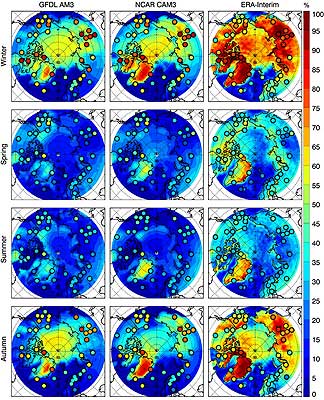September 12th, 2011
Key Findings
- In both polar regions, SBIs are more frequent, deeper, and stronger in winter and autumn than in summer and spring, and diurnal variations are found in summertime.
- The climate models show similar seasonal patterns and spatial distributions of SBI properties as the radiosonde observations, but with biases in their magnitudes.
- SBI frequency, depth and intensity are positively correlated, both spatially and temporally, and all three are anti-correlated with surface temperature.
Yehui Zhang, Dian J. Seidel, Jean-Christophe Golaz, Clara Deser, and Robert A. Tomas. Journal of Climate – doi:10.1175/2011JCLI4004.1.
Summary

Surface-based inversions (SBI) are frequent features of the Arctic and Antarctic atmospheric boundary layer and influence important climate processes. However, prior to this study, climatological polar SBI properties had not been fully characterized, nor had climate model simulations of SBIs been compared comprehensively to observations. Using 20 years of radiosonde observations, and simulations from two state-of-the-art climate models, this study examines the spatial and temporal variability of three SBI characteristics – frequency of occurrence, depth (from the surface to the inversion top), and intensity (temperature difference over the SBI depth) – and relationships among them.
Data sparseness limits the analysis over the Arctic Ocean and over most of Antarctica. This analysis is part of an ongoing research effort that attempts to bridge the sub-disciplinary divide between boundary layer meteorology and climate science through observational and model analyses of different types of atmospheric boundary layers in different regions of the globe.


